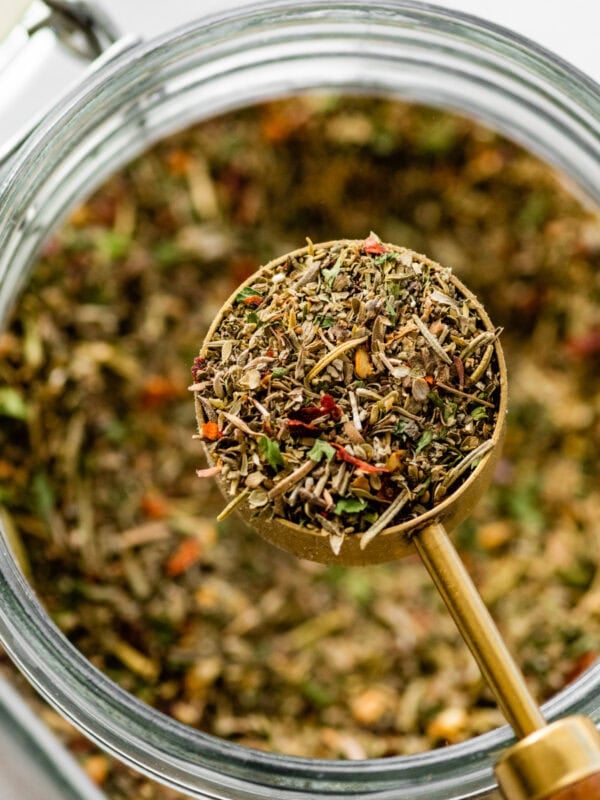What’s the Best Bread for Stuffing? (Thanksgiving)
Updated May 10, 2025, Published Nov 18, 2023
This post may contain affiliate links. Please read our disclosure policy.
It’s time to start planning your Thanksgiving meals! If you are wondering- what is the best bread for stuffing? I’ve got you covered! It’s one of the most common side dishes for this holiday feast.
Serve your favorite stuffing recipe with roasting chicken and green bean casserole.

Made with your choice of bread, broth, fresh herbs, and other additions like sausage or vegetables, it is the perfect accompaniment to any Thanksgiving dinner.
Whether using a tried and true recipe passed down from your grandmother or one from your favorite chef, the success of this dish is largely dependent on the bread that you use. Choosing the best bread for stuffing can mean the difference between a melt-in-your-mouth experience and a soggy mess.
Pair this with our turkey recipe to complete your Thanksgiving table!
Table of Contents
Types of Bread
There are as many different types of bread as there are bread makers; however, most can be categorized into leavened and non-leavened and even into soft or hard bread.
Unleavened bread does not use a leavening (rising) agent such as yeast, baking soda, or baking powder and results in a flatter, denser textured product. Crackers, tortillas, and crepes are all examples of unleavened bread.

Leaven breads use some type of agent, such as yeast, to make it rise, which creates a puffier, less dense bread. There are soft and hard breads within leaven bread. Soft breads tend to be lighter and fluffier, while hard breads are denser and heavier.
The amount of liquids in the dough has a direct impact on the texture of the bread. More water creates softer bread with more air pockets, while less water creates that dense loaf with a tight crumb.
Of course, the types of flour and grains used in the recipe can also have a direct impact on the density of the bread.
You can make stuffing with leftover homemade cornbread by toasting it first to harden it a bit. Cornbread is a staple ingredient rather than white bread. In the northern US, stuffing is traditionally stuffed inside the turkey and baked.

The Best Types of Bread for Stuffing
Stuffing recipes generally call for using bread cubes and adding broth. This is why choosing the right type of bread can have such an impact on the outcome.
Adding chicken broth to soft, fluffy bread will make a soggy mess that will not provide the dining experience that you are looking for.
Most recipes suggest using a loaf that is heavier and denser yet still crusty and flavorful, such as sourdough bread, or a hearty, slightly dense white bread like French bread or this easy, Italian no knead bread. Other options are a sturdy sandwich loaf, brioche, challah, ciabatta, or even focaccia bread.
Since you will be adding a liquid, stale bread works best here as it tends to be slightly drier, so I recommend buying it one to three days in advance to give it a chance to dry out a bit.
The stale or dry bread will hold up better after cooking and keep its texture even after adding chicken stock or liquid, providing you with a moist center and a crispy top. To customize the recipe to fit your tastes, simply changing the bread can go a long way. But, remember, good stuffing is moist but never wet!

Stuffing Tips and Tricks
Though not a complex dish to put together, there are a few things that you want to consider when making it. The key ingredient is the kind of bread. Make sure to have your fresh bread on hand a few days before making your stuffing.
If you are adding vegetables like onions, celery, or carrots, dice them into similar-sized pieces and lightly sauté them before mixing them with your bread to ensure that they are tender and cooked through.
Mix your dry ingredients in a large bowl before adding your liquid. Choose your liquid based on your tastes. You can use chicken or turkey broth, or change it up and use vegetable broth, gravy, lots of butter, or olive oil.
Regardless, add it a little at a time to your dry ingredients and mix. You don’t want to add too much at once as you don’t want a soggy mess.
It is easy to add more but impossible to take out if you add too much. You want your dressing moist but not soggy and do not want too much liquid in the bottom of the bowl.

Variations and Add-Ins for Stuffing
There are as many variations of bread stuffing as turkeys on the Thanksgiving table. This delectable side dish is easily adaptable to not only complement the main dish but also suit your tastes. Something as simple as switching up the type of bread you use can change the entire taste of this dish. Instead of French or Italian bread, try cornbread.
Experiment with herbs and spices. Try using fresh instead of dry herbs. Use pre-made poultry seasonings or create your own with parsley, sage, rosemary, and fresh thyme. Add in some chopped onion, celery, or other vegetables like carrots to provide additional texture.

If you want to go a more savory route, add in some Italian sausage. Go all out and create a decadent oyster stuffing by adding chopped oysters, poultry seasoning, salt, and black pepper. Use wild mushrooms or rice to change it up even more. It’s all up to your preference and how out of the box you want to go on Thanksgiving day.
With a never-ending supply of recipes to try, only your imagination can limit you when creating the perfect Thanksgiving stuffing. Take the time to experiment and try out a new recipe, or take that leftover stuffing from the big day and turn it into a new and exciting dish to try.
The History of Stuffing
The first recorded recipes for stuffing can be found as early as the 2nd century BC in a Roman cookbook by Apicius De Re Coquinaria, which contains recipes for stuffed chicken, dormouse, hare, and pig.
Stuffing consisted of common ingredients found at that time, such as vegetables, herbs and spices, nuts, and grains, and often included chopped organ meats as well.
Over the centuries, the recipes for this family favorite have most certainly changed based on the ingredients that could be found and the culture and traditions of the people. Recipes were created from available ingredients and were adapted to fit taste and budget.
Leftover bread, cornbread, and rice, as well as available herbs and vegetables, dictated what went into stuffing. It wasn’t until the 1970s that pre-packaged, boxed stuffing mix appeared on the grocery store shelves.
Recipes and even the name tend to differ from one area of the country to another. In the southern US, stuffing is often referred to as dressing and is typically baked in a casserole dish instead of stuffed inside the turkey.
If you’re looking for the best Thanksgiving stuffing recipe, you can find my easy stuffing recipe here.
Leave a comment and star rating on the recipe to let me know how it turned out! Happy Thanksgiving from my family to yours!







